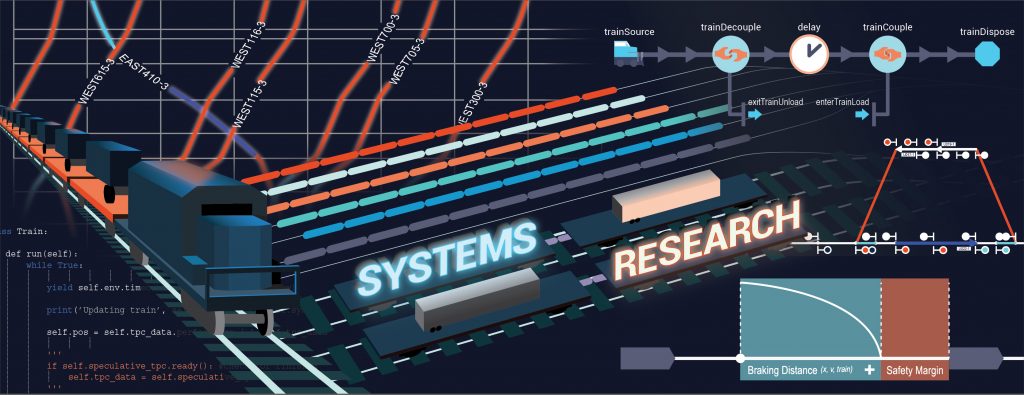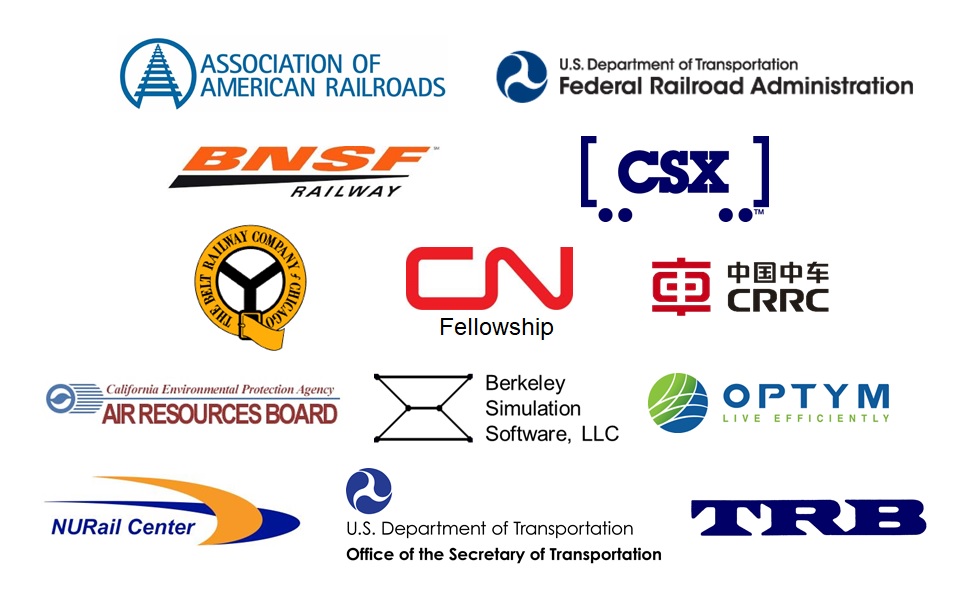The RailTEC Systems Group at the University of Illinois at Urbana-Champaign conducts research related to improving the operational performance, capacity and efficiency of the railway network. Demand for sustainable freight transportation will continue to increase in the future. At the same time, there continues to be strong support for expanded commuter and intercity passenger rail services operating at higher speeds on more frequent schedules. The need to handle growing levels of both heavy-axle-load freight trains and higher-speed passenger trains on the same infrastructure can strain the capacity of the North American rail network, resulting in delay, unreliable services and losses in efficiency. Maintaining a high level of service under anticipated freight and passenger traffic volumes will require changes in operating strategies, infrastructure investment, and adoption of new technologies such as advanced control systems with moving blocks or autonomous trains. Making these changes and investments in an optimal manner requires a thorough understanding of the fundamental relationships between track infrastructure, traffic levels, train characteristics, level of service, operating efficiency and technology-assisted train operations. Through research, the RailTEC Systems Group seeks to increase knowledge of these fundamental rail system relationships within the context of both railway mainlines, and yards and terminals, and how mainlines, yards and terminals interact to determine the overall performance, capacity and efficiency of the rail network.

Research Tools
The RailTEC Systems Group makes extensive use of railway mainline, yard and terminal simulation models:
- Mainline corridor simulations are conducted with Rail Traffic Controller (RTC) software from Berkeley Simulation. The de facto North American standard rail simulation standard, RTC is used by multiple Class 1 Freight Railroads, passenger operators and consulting firms to model railway operating plans and investigate capital expansion projects. RTC emulates real dispatcher decisions in moving trains across a rail network while generating performance and efficiency statistics.
- Classification yards are simulated with YardSYM from Optym, a discrete-event simulation model developed specifically for analysis of hump classification yards. Users specify a yard layout, traffic pattern, operating parameters and crew resource levels through an integrated simulation environment that outputs key performance metrics and produces realistic animation of yard operations.
- Intermodal terminal simulation models are constructed with AnyLogic, a Java-based simulation software with applications in transportation planning and operations research. Special-purpose road and rail libraries in AnyLogic allow users to develop large-scale, multi-purpose intermodal terminal models using interactive agents.
- Custom railway simulations and train performance calculations are also developed in SIGMA and using the SimPy discrete-event simulation engine with Python.
The RailTEC Systems group supplements simulation data with optimization models, statistical analysis and other train performance calculation tools to develop analytical and statistical models of rail system behavior to better support industry decisions. Specific tools include:
- Optimization with GAMS/CPLEX
- Heuristic algorithms in MATLAB, Python, Java, C++
- Spatial and geographic analysis with ESRI Arc GIS
- Statistical analysis with SAS, JMP, R, Access, Tableau
Research Projects
Current and recent RailTEC Systems group research projects include:
-
- International Approaches to Capacity and Safety of Shared Freight and Passenger Rail Lines (University of Birmingham, UK)
- Leveraging Connected Highway Vehicle Platooning Technology to Improve the Efficiency and Effectiveness of Train Fleeting (FRA)
- Relative Capacity and Performance of Fixed and Moving Block Train Control Systems (NURail/AAR)
- Machine Learning Prediction of Traction Motor Failures (CRRC)
- Quantifying Intermodal Facility Capacity Factor Interactions through Simulation (NURail/AAR)
- US Rail Transit and Intercity Passenger Rail Market Research (CRRC)
- Traffic Complexity and Railway Hump Classification Yard Performance and Capacity (NURail/AAR)
- Train Delay and Railway Line Capacity Under Combinations of Structured and Flexible Operations (NURail/AAR)
- Mixed Freight and Higher-Speed Passenger Trains: Guidance on Superelevation (FRA)
- International Survey of Railroad Capacity Modeling Tools (FRA)
- Capacity of Single-Track with Short Sidings to Support Operation of Long Trains (NURail/AAR)
- Optimal Infrastructure Expansion Strategies for Increased Capacity of Mixed-Use Freight and Passenger Rail Corridors (NURail/AAR)
- Railroad Decision Support Tools for Track Maintenance (NURail/AAR)
- Passenger Rail Energy Consumption and Emissions Relative to Competing Modes (NCRRP/TRB/FRA)
- Economic and Operating Impacts of Implementing Low-Emissions Locomotive Technologies (CARB)
- Optimization of Investments to Improve Passenger Rail Corridor Performance (AAR)
- Guidebook for Railway-themed K-12 STEM Outreach Activities (NURail)
For more information on RailTEC research on railway system operational performance, capacity and efficiency, contact: Dr. C. Tyler Dick.
Current and Recent Research Sponsors and Supporters
The RailTEC Systems Group would like to thank the following organizations for their financial and in-kind support of both basic and applied research projects addressing research questions related to the operational performance, capacity and efficiency of the rail network.
-
- Association of American Railroads (AAR)
- Belt Railway of Chicago (BRC)
- Berkeley Simulation Software
- BNSF Railway
- California Air Resources Board (CARB)
- CN Railway Engineering Fellowship
- CRRC Institute
- CSX Transportation
- Federal Railroad Administration (FRA)
- National Cooperative Railroad Research Program (NCRRP) of the Transportation Research Board
- National University Rail Center(NURail)
- Optym




